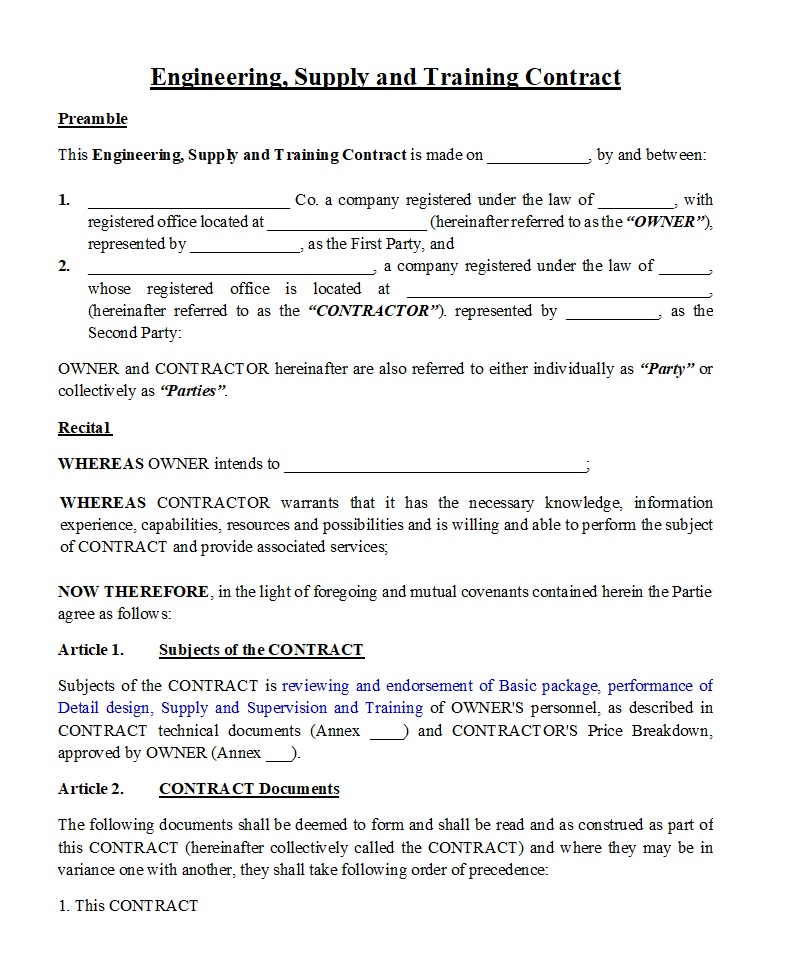Estimated reading time: 3 minutes
An Engineering, Supply, and Training Contract (EP) combines technical design, procurement, and training services under one comprehensive agreement. It applies to industries that use complex equipment or technology. These include power generation, manufacturing, oil and gas, and infrastructure. The contract gives the client equipment, engineering services, and the training needed to operate and maintain the system effectively.
Definition and Scope
The EP contract includes three parts: engineering, procurement, and training. Engineering covers design, analysis, and planning. Procurement handles the sourcing and delivery of materials or equipment. Training builds the client’s operational skills. Together, these parts support the full project lifecycle from study to operation.
Common services under an EP contract include:
- Feasibility and conceptual design studies.
- Basic and detailed engineering works.
- Equipment selection, procurement, and supply management.
- Preparation of construction data and technical documentation.
- Training programs for client personnel on installation, operation, and maintenance.
This structure streamlines coordination between technical design, material supply, and workforce development, ensuring a smooth transition from project execution to long-term operation.
Purpose and Advantages
The purpose of an Engineering, Supply, and Training Contract is to provide the client with a single, integrated source for project execution. It minimizes communication gaps between multiple contractors, reduces administrative complexity, and promotes accountability through a unified contractual framework.
Such contracts deliver significant benefits:
- Efficiency: Combining engineering and procurement avoids delays and incompatibility between design and materials.
- Quality Assurance: The same team that designs the system ensures that all components meet required technical standards.
- Knowledge Transfer: Training helps the client’s team operate and maintain the equipment safely and efficiently.
- Cost and Schedule Control: Integration reduces duplication of effort and improves project predictability.
Industry Application
EP contracts are common in complex projects where precision and coordination are critical. Power plants, manufacturing lines, water treatment systems, and data centers often rely on this structure to ensure technical integrity and operational readiness.
For example, in a renewable energy project, an EP contractor might handle the turbine design, procure the required components, and train the client’s engineers to maintain and monitor the system. This integrated approach enhances project reliability and long-term sustainability.
Best Practices
Successful EP contracts require detailed specifications, clear performance indicators, and well-defined responsibilities. Both parties should establish measurable outcomes for design quality, delivery timelines, and training effectiveness. Transparent communication and proper documentation throughout the project ensure smooth execution and compliance with international engineering standards.
By uniting design, supply, and training in one contract, the EP model provides clients with a technically sound, cost-effective, and sustainable project delivery method.
Related Templates:
References:
- FIDIC – Conditions of Contract for Plant and Design-Build
- Project Management Institute (PMI) – Integrated Engineering and Procurement Processes
- Institution of Civil Engineers (ICE) – Engineering Procurement Contract Guidance
- Engineering News-Record (ENR) – Best Practices in EPC and EP Contracting
has been added to your cart!
have been added to your cart!



